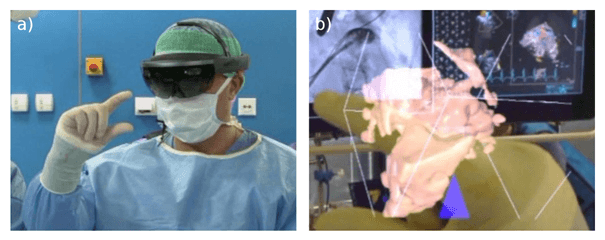Defining realities
Virtual reality (VR) is the application of computer technology to generate a three-dimensional simulated environment in which the user not only experiences but also interacts with the projected artificial environment, colloquially referred to as an immersive experience. This virtual reality is commonly rendered with a head-mounted display device. Augmented reality (AR) enhances real-world viewing with digitally generated components which provides the user with a more faithful representation of observations. Whereas VR engages a user in an artificial environment and AR superimposes digital objects on the real-world environment, mixed reality (MR) merges the fundaments of both VR and AR, in other words, a user can interact and manipulate both real and virtual items.

Mixed reality techniques within the cardiology field
Instinctively mixed reality technologies lends itself well to educational domains. A number of MR derived training applications have been previously reported. The HoloAnatomy programme at Case Western Reserve University (Cleveland, Ohio, USA) resulted in the first MR healthcare application1. The Lucile Packard Children’s Hospital Stanford (Palo Alto, California, USA) developed novel interactive visualisations as part of their Stanford Virtual Heart Project so that paediatric cardiologists can explain complex congenital heart defects to both trainees and patients alike.2
Additionally mixed reality technologies are gradually being introduced into pre-procedural planning protocols3,4. Cardiac DICOM image visualization in three-dimensional simulated environment provides the user an enhanced appreciation of depth perception entailing accurate volume measurements and higher quality data management. It is principally correlated to computed tomography or magnetic resonance studies performed prior to specific cardiac procedures5. When comparing three-dimensional displays generated by AR or VR techniques to standard flat screens monitor displays data interpretation time is reduced with similar results in terms accuracy.

Challenges and further works
It is clear that the promise presented by MR techniques in the medical field are almost infinite. Nevertheless, numerous iteration cycles will be fundamental before a comprehensive adoption can be considered. Among the current limitations are the concerns with precise stereoscopy views in VR and small view fields in AR devices. Conventional developments factors such as cost, size, weight and computer power will be detrimental to success.
Conflict of Interest
Zlahoda-Huzior and Maciej Stanuch are scientific developers for MedApp SA, Krakow, Poland. Dariusz Dudek is a member of the Scientific Board, MedApp SA, Poland.






 Our mission: To reduce the burden of cardiovascular disease.
Our mission: To reduce the burden of cardiovascular disease.